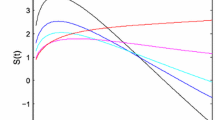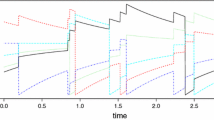Abstract
The Ornstein–Uhlenbeck process arises from a leaky stochastic integrate-and-fire model of the membrane potential of a neuron, in which its firing corresponds to the first time the process hits a barrier. We address the problem of estimating the parameters of the underlying process when the available data are the neuron’s successive spikes, or spike train. The first-hitting time density is not tractable, so we use its Laplace transform to determine the identifiable parameters of the model, show that their maximum likelihood estimates are consistent and asymptotically normal, and describe computational methods to obtain the estimates and their standard errors.



Similar content being viewed by others
References
Barndorff-Nielsen O, Blaesild P, Halgreen C (1978) First hitting time models for the generalized inverse Gaussian distribution. Stochastic Process Appl 7:49–54
Capocelli RM, Ricciardi LM (1973) A continuous Markovian model for neuronal activity. J Theor Biol 40:369–387
Churchill RV (1981) Operational mathematics. McGraw-Hill
Darling D, Siegert A (1953) The first passage problem for a continuous Markov process. Ann Math Stat 24:624–639
DeHoog FR, Knight JH, Stokes AN (1982) An improved method for the numerical inversion of Laplace transforms. SIAM J Sci Stat Comput 3:357–366
Ditlevsen S, Lansky P (2005) Estimation of input parameters in the Ornstein-Uhlenbeck neuronal model. Phys Rev E 71
DuMouchel W (1973) On the asymptotic normality of the maximum likelihood estimate when sampling from a stable distribution. Ann Stat 1:948–957
Gerstein G, Mandelbrot B (1964) Random walk models for the spike activity of a single neuron. Biophys J 4:41–68
Hodgkin AL, Huxley AF (1952) A quantitative description of membrane current and its application to conduction and excitation in nerves. J Physiol 117:500–544
Inoue J, Sato S, Ricciardi LM (1995) On the parameter estimation for diffusion models of single neuron’s activities. Biol Cybern 73:209–221
Iyengar S, Liao Q (1997) Modeling neural activity using the generalized inverse Gaussian distribution. Biol Cybern 77:289–295
Jorgensen B (1981) The generalized inverse Gaussian distribution. Springer
Kallianpur G (1983) On a diffusion approximation to a discontinuous model for a single neuron. North Holland, In Contributions to Statistics
Koch C (1999) Biophysics of computation: information processing in single neurons. Oxford
Lebedev NN (1972) Special functions and their applications. Dover
Lehmann EL (1983) Theory of point estimation. Wiley
Madec Y, Japhet C (2004) First passage time problem for a drifted Ornstein-Uhlenbeck process. Math Biosci 189:131–140
Mullowney P, Iyengar S.: (2006) Maximum likelihood estimation of an integrate-and-fire neuronal model. Submitted to J Neural Computation
Olver FWJ.: (1974) Asymptotics and special functions. Academic Press
Olver FWJ, Lozier DW, Boisvert RF, Clark CW (2010) NIST handbook of mathematical functions. Cambridge University Press
Paninski L, Pillow JW, Simoncelli EP (2004) Maximum likelihood estimation of a stochastic integrate-and-fire neural encoding model. Neural Comput 16:2533–2561
Ricciardi L.: (1977) Diffusion processes and related topics in biology. Springer
Ricciardi L, Sacerdote L (1977) The Ornstein-Uhlenbeck process as a model for neuronal activity. Biol Cybern 35:1–9
Ricciard L, Sato S (1988) First passage time density and moments of the Ornstein-Uhlenbeck process. J Appl Probab 25:43–57
Seshadri V (1999) The inverse Gaussian distribution. Springer
Stein RB (1965) A theoretical analysis of neuronal variability. Biophys J 5:173–194
Tuckwell H (1988) Introduction to theoretical neurobiology, vol 2: nonlinear and stochastic theories. Cambridge
Uhlenbeck G, Ornstein L.: (1930) On the theory of Brownian motion. Reprinted in Selected papers in Noise and Stochastic Processes. (1954) N. Wax, ed. Dover
Yi B.: (2018) Inference based on boundary crossings of diffusions. Ph.D. thesis, Statistics Department, University of Pittsburgh
Author information
Authors and Affiliations
Corresponding author
Ethics declarations
Conflict of interest
The author has no conflicts of interest.
Additional information
Dedicated to Professor C. R. Rao on the occasion of his 100th birthday.
Publisher's Note
Springer Nature remains neutral with regard to jurisdictional claims in published maps and institutional affiliations.
This article is part of the topical collection “Celebrating the Centenary of Professor C. R. Rao” guest edited by Ravi Khattree, Sreenivasa Rao Jammalamadaka, and M. B. Rao.
Rights and permissions
About this article
Cite this article
Iyengar, S. Maximum Likelihood Estimation for an Ornstein–Uhlenbeck Model for Neural Activity. J Stat Theory Pract 15, 46 (2021). https://doi.org/10.1007/s42519-021-00190-3
Accepted:
Published:
DOI: https://doi.org/10.1007/s42519-021-00190-3
Keywords
- First-passage time
- integrate-and-fire model
- Laplace transform
- Maximum likelihood
- Parabolic cylinder function
- Renewal process
- Integrate-and-fire model




